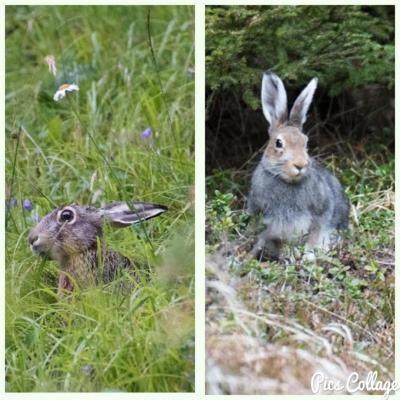
In Switzerland, there are two types of lagomorph in our forests and mountains: the hare (Lepus europaeus) and the mountain hare (Lepus timidus). The first is found in both plains and mountains, while the latter is found in mountainous environments, at altitudes of between 1500 and 2500m.
The hare is easily recognized by its long, black-edged ears, brown/grey coloring and long legs. He weighs between 3 and 6 kg and is between 50 and 70 cm long. Its diet varies from plants, seeds, roots, vegetables, herbs, garden flowers and mushrooms. Its lifespan varies between 5 and 12 years.
 The mountain hare is best known for one special and distinctive features: its coat color varies with the seasons. He's brown in summer and white in winter, camouflaging itself in snowy pastures. He's smaller than hare, weighing around 3 kg and 50cm long. Its ears are shorter, but its legs are wider, serving as "snow shoes" in winter. He looks more like the cottontail rabbit, with a rounder silhouette. In terms of food, he also has a more robust stomach, enabling him to eat tree bark and purge itself with gravel or earth. His lifespan varies between 4 and 5 years.
The mountain hare is best known for one special and distinctive features: its coat color varies with the seasons. He's brown in summer and white in winter, camouflaging itself in snowy pastures. He's smaller than hare, weighing around 3 kg and 50cm long. Its ears are shorter, but its legs are wider, serving as "snow shoes" in winter. He looks more like the cottontail rabbit, with a rounder silhouette. In terms of food, he also has a more robust stomach, enabling him to eat tree bark and purge itself with gravel or earth. His lifespan varies between 4 and 5 years.
 What these lagomorphs, members of the Leporidae family, have in common is that, like many of their prey, they reproduce quite intensively. Females give birth 3 to 4 times a year, with 3 to 5 babies hare per litter. So they are prolific and the favorite prey to predators such as foxes, wolves, lynxes, carrion crows, certain large birds of prey (falconidae and strigidae), domestic dogs and wild cats.
What these lagomorphs, members of the Leporidae family, have in common is that, like many of their prey, they reproduce quite intensively. Females give birth 3 to 4 times a year, with 3 to 5 babies hare per litter. So they are prolific and the favorite prey to predators such as foxes, wolves, lynxes, carrion crows, certain large birds of prey (falconidae and strigidae), domestic dogs and wild cats.
In our video, you can see a pair of hares evolving together, who see a mountain hare land on their path. At first, there's an observation phase, with none of them moving. Then one of the hares approaches the mountain hare and attacks him with his paws, trying to dislodge it. Unfortunately, the video cut out at this point, but it's clear that the mountain hare was not welcome.
We can clearly see the morphological difference, as well as the color. Essentially nocturnal, the hares and varying hares were filmed here in broad daylight, in a rather rare interaction.
Article : TT - Wolf Mission
Photos : Wolf Mission & Salamandre Magazine
Video : Wolf Mission




 What these lagomorphs, members of the Leporidae family, have in common is that, like many of their prey, they reproduce quite intensively. Females give birth 3 to 4 times a year, with 3 to 5 babies hare per litter. So they are prolific and the favorite prey to predators such as foxes, wolves, lynxes, carrion crows, certain large birds of prey (falconidae and strigidae), domestic dogs and wild cats.
What these lagomorphs, members of the Leporidae family, have in common is that, like many of their prey, they reproduce quite intensively. Females give birth 3 to 4 times a year, with 3 to 5 babies hare per litter. So they are prolific and the favorite prey to predators such as foxes, wolves, lynxes, carrion crows, certain large birds of prey (falconidae and strigidae), domestic dogs and wild cats.